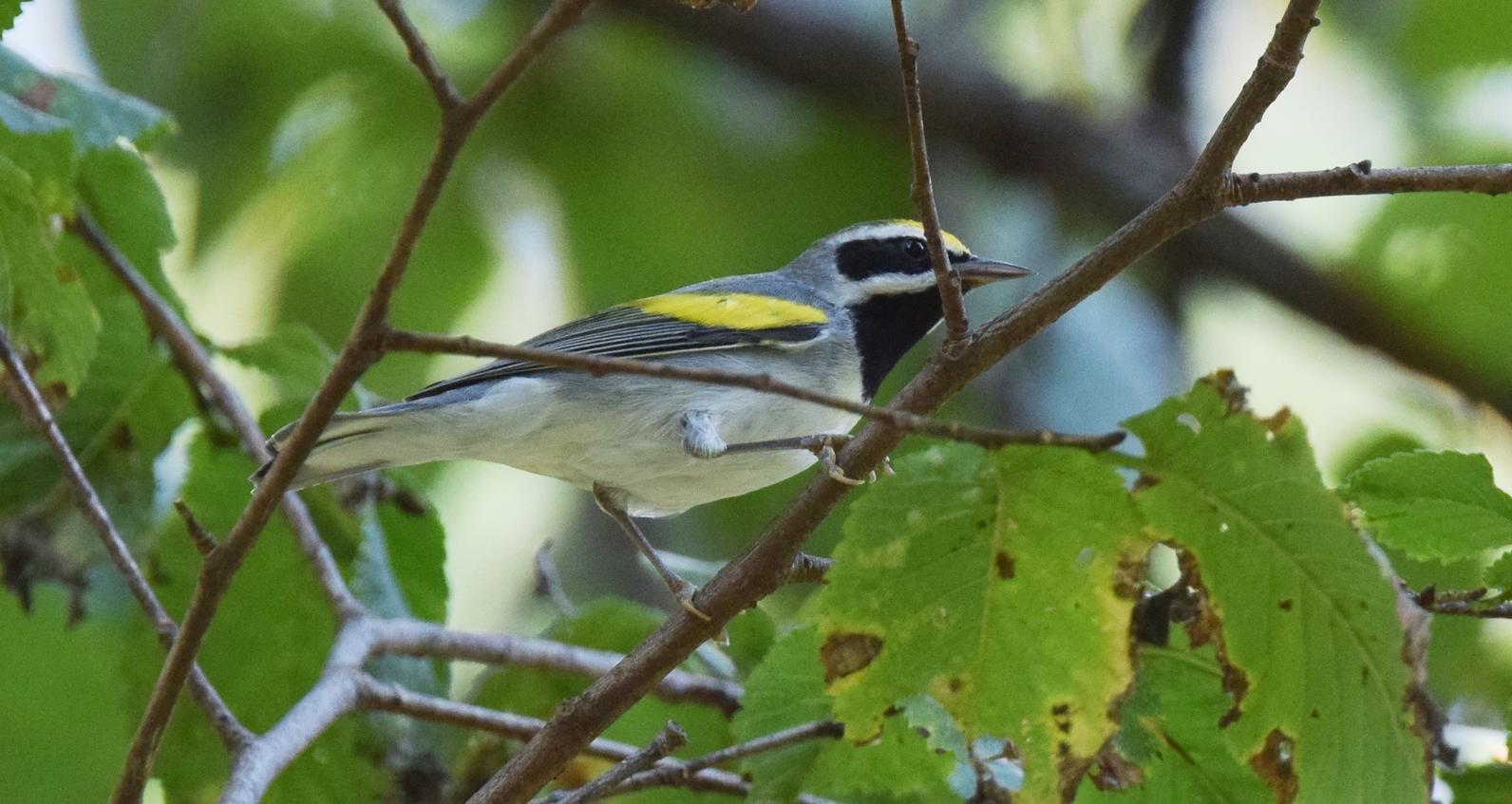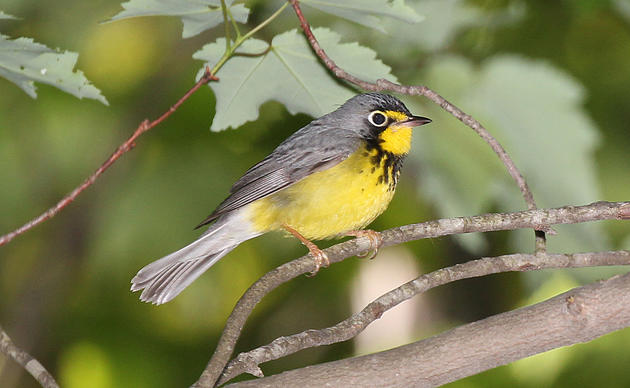Golden-winged Warbler
New York State’s old fields, shrublands, and young forests are home to significant populations of some of the highest priority birds in the Atlantic Flyway. These birds depend on the habitats that grow back after natural and human-caused disturbances. Many of these species are in steep decline and at risk of disappearing from the New York landscape, but by working together, we can help their populations recover. Private and public landowners and land managers can restore young forest habitat, ensuring that these treasured birds are part of our ecosystem for future generations.

Golden-winged Warblers and other young forest species like Willow Flycatcher, Brown Thrasher, Eastern Towhee, and Chestnut-sided Warbler rely on young open forest with shrubby areas for breeding success.
Below is some background and information on steps you can take if you own or manage land that has potentially high-quality habitat for bird species. Throughout the year, Audubon New York staff holds a series of habitat management workshops around the state. If you’re interested in learning more about the workshops or would like to talk with us about the potential of your land, please email us.
Background
Historically, young forests and other early-successional habitats were created and maintained through natural disturbances such as fire, flooding, insect outbreaks, and beaver activity, as well as the actions of humans, like logging and farmland abandonment. Today, however, land use is very different than what it once was. Decades of suppression of these natural processes and changes in human land use have resulted in a landscape lacking in this critical habitat type, with serious implications for wildlife.
Young forest, also known as shrubland, is an early-successional habitat usually present due to a disturbance, and is typically defined as sites with persistent shrubs and/or seedling to sapling sized trees. With a temporary nature, young forest only lasts about 10-15 years before growing into more mature forest without any further disturbance. Historically, natural disturbances including fire damage, flooding, often as a result of beaver presence, and insect outbreaks have maintained this habitat. Forest management including clearcutting, and abandonment of farmland have also resulted in young forest habitat. In recent decades, many of these disturbance factors have been suppressed, resulting in a landscape of mostly mature forest in a similar age class. It is important now for land managers to mimic these historical disturbances by creating or maintaining young forests to benefit the birds that need it and to help diversify forest age classes across the landscape.
Golden-winged Warbler Decline and Habitat Needs
Young forest habitat is important breeding habitat for several bird species as well as other wildlife, including Ruffed Grouse, American Woodcock, Eastern Towhee, Brown Thrasher, Field Sparrow, Willow Flycatcher, Prairie Warbler, New England cottontail, White-tailed Deer, and Red Fox. In Northern New York, Audubon New York is focused on managing young forest habitat for Golden-winged Warblers and associated young forest/shrubland species. A Species of Concern, Golden-winged Warblers have declined range-wide by 2.6% per year since 1966, and in New York, this species has declined by 5.3% per year from 1966 to 2011. This significant decline in population is driven largely by habitat loss as well as hybridization with the closely related Blue-winged Warbler. Golden-winged Warblers rely on young open forest with a mix of tall shrubs and saplings (3-13 feet high), interspersed with small areas of herbaceous cover (forbs and grasses), and intermittent overstory deciduous trees (>9 inches diameter breast height) for song perches. Each habitat patch should be at least 5 acres if it is within 1,000 feet of existing young forest habitat, or at least 25 acres if it is more than 1,000 feet from existing habitat. At a landscape scale, within 1.5 miles of young forest habitat, Golden-winged Warblers prefer >50% forest cover composed of at least 70% deciduous trees. Sites within a landscape matrix of agricultural fields (particularly row crops) and more than 1 mile away from other young forest patches are not ideal.
Management Recommendations
Young forest habitat can range from abandoned farmland (old fields overgrown with shrubs) to hardwood swamps with scattered trees, to regenerating shoots and saplings after a clear-cut timber harvest. To achieve the structural diversity of vegetation described for Golden-winged Warbler habitat requirements (see above), managers can employ clear cuts, leaving enough perch trees scattered throughout the cut, they can clear an excess of shrub cover using brush hog mowers, or can even accelerate succession of old fields by planting native shrubs or tree seedlings.
Some specific management techniques for “re-setting” habitat succession to the young forest stage:
Timber management: Use an even-aged forest management technique to create a ≥5 acre opening, retaining at least 5-15 trees per acre. The management target for canopy trees is basal area of 10-35 ft2/acre, or 10-30% canopy cover. Retained trees should be mostly deciduous or standing snags. If the patch is more than 1000 feet from existing young forest habitat, it should be at least 25 acres in size.
Feathered edge: Thin trees to create irregular spacing and a gradual transition from open to closed canopy at the edge of a forest patch. The transition zone should be approximately 150 feet wide.
Selective tree felling: In an old field setting, if more than 15 trees per acre exist, thin trees to reduce canopy cover to between 10-30% cover (basal area of 10-35 ft2/acre) and reach the 5-15 trees/acre target for Golden-winged Warbler habitat. Retain mast producing species when possible, including oak, hickory, hawthorn, or apple, and target conifers for removal first. Retain trees in aggregated clumps. Selectively felling trees will open the canopy to increase sunlight for herbaceous structure.
Mowing: If shrubs are uniformly distributed or contain few or no patches of herbaceous plants (forbs, grasses, and sedges), cut or mow shrubs into irregular clumps. Target invasive shrubs first when reducing shrub structure, such as honeysuckle, multiflora rose, and buckthorn. Mow site every 3-4 years around clumps of shrubs/saplings, to maintain patchy habitat structure.
Additional management techniques for “accelerating” old field habitat to the young forest stage:
Plant desired species: If habitat structure contains too many forbs and grasses, plant fast growing, native deciduous shrubs and tree seedlings. If there are too many grasses and not enough forbs, reduce mowing to every 3-5 years, and plant appropriate native shrubs/saplings. Plantings should be done in clumps to create a patchy distribution at the management site. Ideal native shrubs for planting include: dogwoods, arrowwood, winterberry, serviceberry, and raspberry/blackberry.”
Recommendations in this document are in part based on information available in the Golden-winged Warbler Status Review and Conservation Plan. Roth, A.M., Rohrbaugh, T. Will, and D.A. Buehler, editors. 2012. Golden-winged Warbler Status Review and Conservation Plan. www.gwwa.org/
How you can help, right now
Donate to Audubon
Help secure the future for birds at risk from climate change, habitat loss and other threats. Your support will power our science, education, advocacy and on-the-ground conservation efforts.




